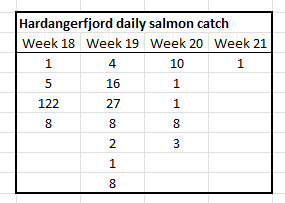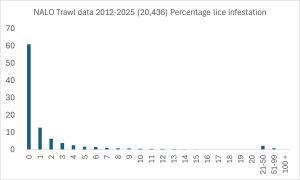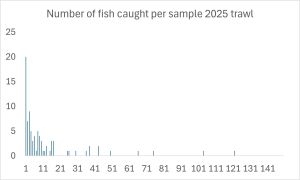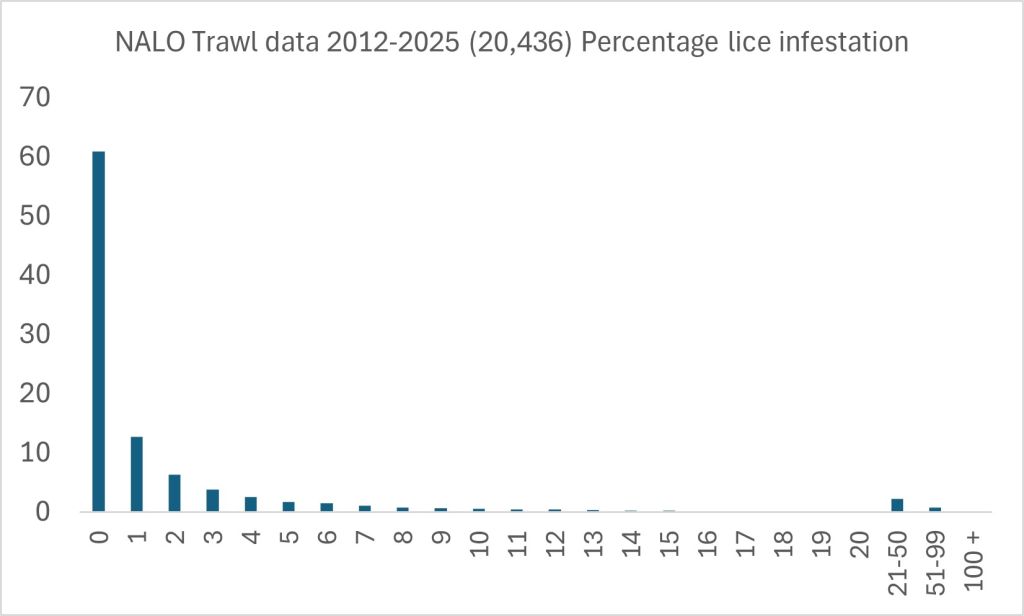Trawling: I was trawling through the Institute of Marine Research’s data website recently and noticed that they have already posted the data from their salmon smolt trawls for 2025. This records the number of lice found on migrating smolts recorded from the five fjords where trawling was conducted during May and June this year.
Back in July, IMR published their interim sea lice report for 2025. This reported on four of the five trawls and can be summarised as the following effects on wild migrating salmon:
Boknafjorden – a moderate negative effect
Hardangerfjord – a high negative effect
Sognefjord – too few fish (16) caught to make any assessment
Romsdalsfjorden – too few fish (9) to make any assessment
The methodology used by IMR produced the following results:

Now that I have the data it is interesting to look at how the data is (or isn’t applied). Firstly, the number of salmon caught in Hardangerfjord in 2025 totals 225 which is one less than in the full dataset However, when I break down the data into the four weeks (week 18-21) I have an extra fish in week 19. I appreciate that it might be considered petty to be discussing a difference of one fish, but this is key data which is used against the salmon farming industry and thus needs to be accurate. When this data becomes most interesting is when the weekly data is broken down into daily catches.

The lowest prevalence calculated by IMR just happens to occur in the one week with the largest daily catch. There are five days that the total catch was just one fish. This is hardly representative of the population. In fact, all smaller samples are unrepresentative and provide a misleading picture of the impacts of lice. It is only when all samples are combined for 2025 that a better representation of lice impacts can be seen.
The total trawl for 2025 was actually less than half that for 2024 and is the lowest trawl since 2014. With sea lice being a hot topic this year, it might be expected that the data should be robust, but it doesn’t appear to be so.
When the data is combined and lice distribution measured, the resulting graph is as follows.

Even though the suggestion is that lice impacts will be high in 2025, the reality is that 62.3% of migrating smolts were totally free of lice. A further 12.9% had just one louse. An infestation of one louse cannot be considered damaging since otherwise sea lice would never survive as a species.
I suspect that with better sampling the number of lice free salmon would be higher. It is only necessary to look at the spread of number of fish caught on a daily basis to see that small samples dominate the catch.

The reality is that the salmon farming industry is being penalised by the inability of research scientists to obtain truly representative samples of wild fish. As I have repeated several times, the scientists who are promoted as sea lice specialists are not parasitologists and seem to be unaware of the relevance of parasite ecology to the sea lice narrative.
I now await the 2025 NALO sea trout data to see how the data, as in previous years, is also unrepresentative of sea lice distributions.
Premature: Towards the end of August, the Norwegian Food Safety Authority (Mattilsynet) issued a warning that high sea temperatures this summer have set the stage for high lice levels in the coming weeks. This is based on reports and analyses from the Institute of Marine Research. Mattilsynet are keen that there is not to be a repeat of the events in Northern Norway last year when lice levels exploded.
However, this warning was probably premature because last year, farms in Northern Norway were not expecting to have to treat so were not prepared. This year they were. Consequently, lice levels have not reached the levels seen last year and hence these warnings were probably unnecessary.
The problem is that those promoting the established narrative about sea lice such as IMR and Mattilsynet are too focussed on the poor science to understand the that they have lost perspective. This is because there is too much reliance on models rather than real life.
Recently, IMR released a report on the events of 2024 claiming that a perfect storm caused the marine heatwave and subsequent explosion of sea lice. Yet, it is unlikely that the perfect storm will be repeated. In their report IMR describe the unique set of conditions that caused the sea temperature in Northern Norway to soar to 18oc.
What interests me about this report is that sea lice expert Anne Dagrum Sandvik who said that as temperature increases, the life cycle of sea lice speeds up, so they become adults faster and start reproducing faster too. She also says that at increased temperatures sea lice become more aggressive and attach to salmon more easily. Even an increase of 1oc has a notable effect.
In the report, Dr Sandvik highlights the sea lice numbers in 2024 from the area of Kvaløya in Troms to Loppa in Finnmark. Usually, lice numbers have been below 2.5 million adult females during the summer but by August numbers had doubled and by October, the numbers of lice estimated to be in local farms reached an estimated 20 million.
At the peak of the ‘epidemic’, farms north of Kvaløya were holding 60 million female lice which were producing 105 million lice larvae every hour in the first week of October.
I would highlight the use of the word estimate in the comments from Dr Sandvik. These are estimates based on sea lice counts from farms. The number measured by the farm on a small number of fish is extrapolated to all the fish held on the farm, but we know from parasite ecology that just because a sample has, for example, 5 lice, it does not mean every fish has 5 lice. It also does not mean that the lice are distributed as a normal curve with some infested with fewer and some infested with more. The graph from the previous commentary shows that most fish have no lice at all. Numbers predicted by IMR are more than likely to be highly overestimated than what actually occured.
However, what interests me most is the prediction of sea lice larvae production. I believe that the distance between the areas mentioned by Dr Sandvick is about 130km and includes many islands. Dr Sandvik estimates that 105 million lice were being produced every hour. That equates to 2,520 million a day. If the infestation lasted for just four days than that would mean that over 10 billion lice were released into the local environment. With such large numbers, it should be possible to detect the sea lice larvae in the open water to confirm the estimates made.
Unfortunately, IMR avoid the question about the inability to detect sea lice larvae in the water body. It is a subject that I have raised several times previously and I am currently awaiting a reply form head of the sea lice steering group, Karin Boxaspen about why sea lice larvae have never been identified in the sea in the numbers and locations predicted.
The suggestion that 105 million sea lice larvae are produced every hour paints the salmon farming industry is a bad light yet there is not a shred of evidence that these lice exist in the numbers predicted and more importantly whether most of these lice larvae actually leave the confines of the farm. Perhaps, IMR should be researching exactly where all these predicted lice larvae are in the water body. They can then use this information to prove their models and show their claims against the industry are truly valid.
IMR have also posted the sentinel cage data for 2025 on their website. Preliminary examination suggests that there are some high lice counts in some of the cages. However, the infestation of sentinel cages is not a straightforward matter as there are other explanations as to how infestation occurs than just that salmon farms are to blame. I will be looking at this data over the coming weeks and will report back.
Canada: Two new sea lice stories from Canada have emerged this week. The first is yet another paper showing that sea lice numbers have remained unchanged following the removal of farms in British Columbia. This looked at nine years of data examining 3,000 juvenile pink and chum salmon between 2026 and 2024 during which time farmed salmon production fell by 95%.
According to Sea West News, Dr Crawford Revie (actually Professor Revie) said that this study provides clear scientific evidence that the removal of salmon farms does not invariably lead to reduced sea lice infestation levels on wild Pacific salmon. He also said that these findings highlight the importance of understanding the range of natural environmental processes that shape sea lice population dynamics. This second point is not something I agree with. It is not necessarily the natural environmental processes that drive infestation, but the life strategy adopted by parasites that does. As Sea West News highlights, Professor Revie is a professor of Data Analytics in the Department of Computer and Information Sciences at the University of Strathclyde. He is not a parasitologist.
I am also minded that not so long ago, Professor Revie held a very different view on sea lice infestation. Back in 2013, Professor Revie was one of four authors who wrote to the Journal of Fish Diseases claiming that Dave Jackson and his colleagues from the Irish Marine Institute had incorrectly calculated that sea lice had a minimal impact on wild fish stocks and that their reanalysis estimated that a third of infested wild fish succumbed. However, this was just playing with statistics as the Marine Institute showed in a video they later released on Vimeo. The lead author of this letter was Martin Krkosek, colleague of Alaxandra Morton.
The second news story from Canada was that Cermaq, together with the Ahosaht First Nation have completed a 22 month farmed salmon production cycle without the need for any mechanical sea lice treatments, although five infeed treatments were needed for a small number of fish towards the end of the production cycle. In 2022, 56 treatments were needed to maintain a sea lice level of 1.93 and this year, with no treatments, the level was maintained at 0.3. The local community demand stricter controls than the DFO with 1.5 during the wild fish migration and 2.5 the rest of the year compared to 2.8 by DFO during the migration time.
My view is that, as Cermaq have shown, sea lice levels can be controlled but the current narrative places too many unnecessary restrictions on sea lice on farmed salmon. The connection between lice on farmed salmon and impacts on wild fish are simply conjecture. Unfortunately, we seem to rely too heavily on experts on data handling than those who understand the life of parasites.
Finally, although the Canadian data leaves no doubt about the relationship between farms and wild fish, the sea lice experts in Norway do not consider what is happening in Canada to reflect the experience in Norway. This is because they might have to admit that they were wrong.
Zero excuses: In a commentary in Intrafish Sondre Eide from Eide Fjordbruk said that sea lice are the Achilles heel of Norwegian salmon farming. He suggests that if we don’t solve the problem now, we will lose growth, position and credibility. He added that if we don’t act now, we will stagnate and in farming stagnation means death. He concludes that fortunately there is a solution and now the politics must keep up. Before I consider his solution, I would ask a fundamental question as to what exactly is the problem that he wishes to solve?
Are sea lice killing farmed salmon or hampering growth. I’ve not heard anyone complain that sea lice are affecting production. In fact, sea lice are just another health issue that affect salmon and as long as they are managed, they don’t cause any real issue. The problem isn’t about farmed salmon at all but that the wild fish lobby have complained for years that sea lice associated with farms are decimating wild fish stocks, even though any evidence is circumstantial. Indeed, the evidence that does exist points to the fact that sea lice have little to do with the declining wild fish population.
Mr Eide is correct, there is a solution and that is we need to have a proper scientific debate on the alleged impacts of sea lice on wild fish. If the science and evidence clearly show that sea lice are responsible for the issues affecting wild fish, then farmers can take appropriate action but if not, then any proposed action is not just a waste of time but also a waste of money.
Mr Eide is very vocal on this issue for two reasons. One is that he has listened too much to what anglers say. He was a guest speaker at the Wild Salmon Connections meeting held earlier this year in London where his position was applauded because it was exactly what the anglers wanted to hear.
So, what is Mr Eide’s solution. It is that the industry adopts his technology of the Watermoon 2.0, a closed contained unit which he says produces salmon with zero sea lice. He has taken the unit through a full production cycle saying that it had zero lice and therefore no delousing. It had close to zero mortality and top fish welfare, It also has low feed factor with more fish per kilo of feed and lower feed cost. It has low energy consumption due to smart water management and design. Finally, the sludge collection is better than the best land-based facilities.
What he doesn’t say is the cost or the cost of production. What he does say is that the technology exists, the knowledge exists, and the will exists but there is no framework to force the industry to adopt this technology. This is because without force the industry is unlikely to buy into Mr Eide’s vision, even though he calls for the industry to stand together and demand appropriate regulations.
When Mr Eide was on the stage in London, I would have liked to ask him a question, but questions had to be posed in advance and vetted in this one session. The Wild Fish Connections organisers didn’t want any difficult questions asked about salmon farming especially as they knew there were a handful of industry people in the audience. The question I would have asked is that what would his response be if the industry invested billions of kroner in new technology such as Watermoon 2.0 as he demands, but wild salmon then continue to rapidly head towards extinction because that is exactly what is and will happen.

